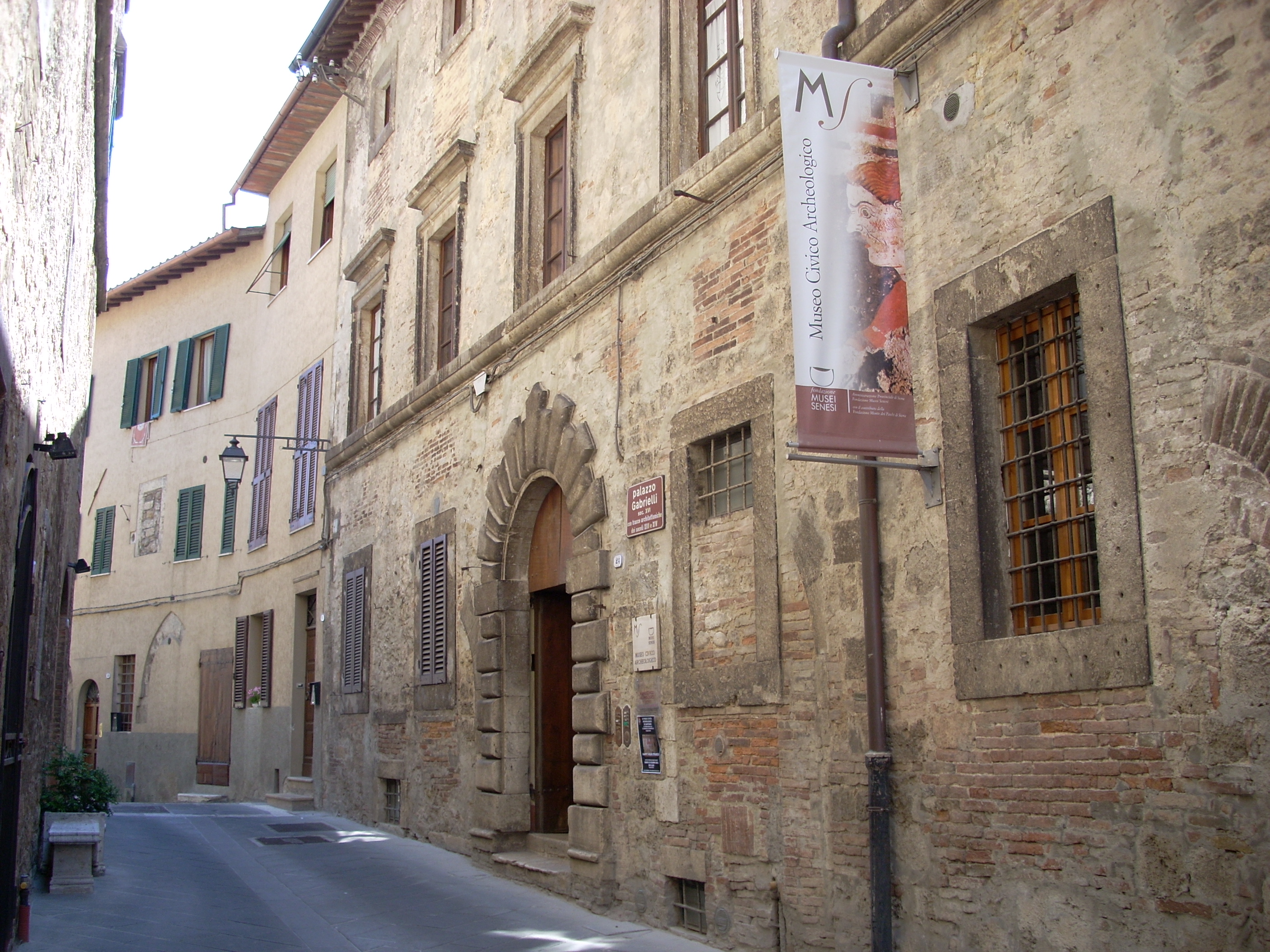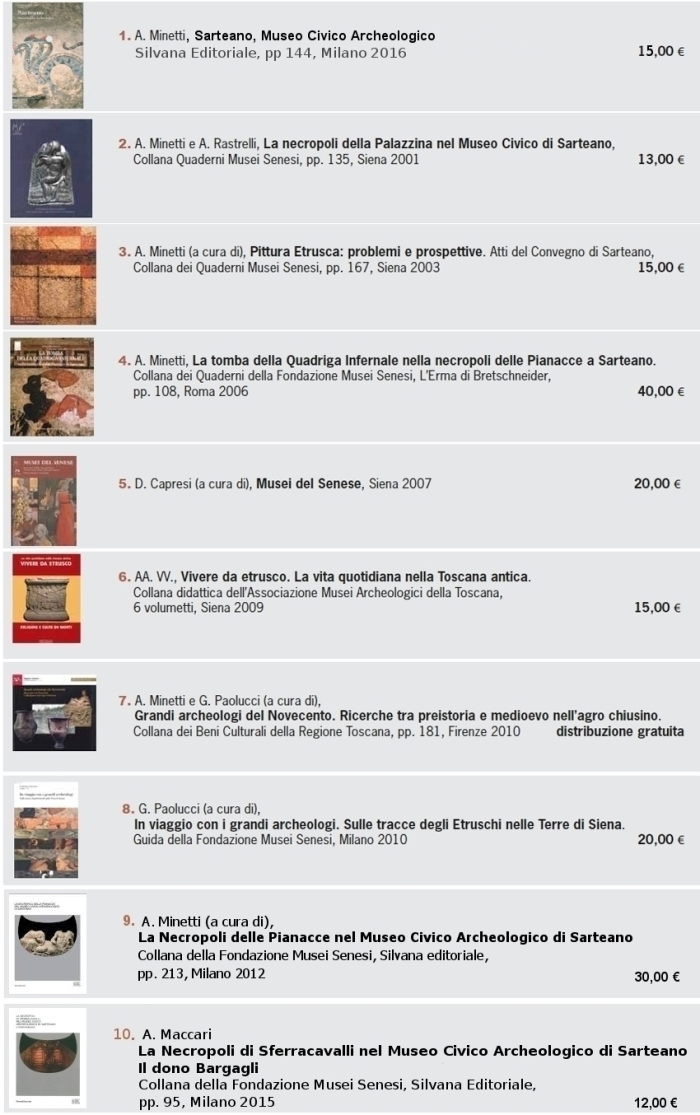
THE MUSEUM
THE BUILDING

The Archaeological Museum of Sarteano is located inside Palazzo Gabrielli, a 16th century building which incorporates clear pre-existing medieval elements, such as the so-called “dead man’s door” in the second room. The door, situated high above road level, was accessible via a ladder that was removed at night to offer more security. Once it had lost its everyday use the door was only opened to let the coffins pass and load them on a cart. The ceiling of the second room is decorated with the emblem of the Gabrielli family and numerous fireplaces adorn the rooms on the first floor. In the basement, that once served as cellars, the foundations are directly resting on a bank of local travertine. The exhibited finds were discovered in Etruscan tombs cut in the same rock creating a suggestive parallelism.
THE STORY
The Museum was inaugurated on 27 September 1997 to house the finds conserved in the warehouses of the Museo Archeologico Nazionale of Florence, coming from excavations of the 2ndhalf of the 19th and 20th centuries. To this were added a small group of finds of the Antiquarium Comunale, which had been exhibited in the Town Hall until 1995, and the private Bologni collection, that was donated to the museum. Material of isolated and fortuitous discoveries had converged in Florence over decades , whereas the only systematic research in the area had been carried out by William Maetzke in the years 1951-54 in the necropolis of Solaia-Macchiapiana-Mulin Canale and Pianacce. Our Museum has dedicated a publication to Maetzke's investigations in 2010 (see below). However, the great amount of artefacts, about 800, that formed the Fanelli collection did not return to their territory of origin. All this material came from excavations carried out in the years 1824-25 in the necropolis of Solaia and had been donated to Grand Duke Leopold in 1826. It had become part of the historic grand-ducal collections and remained therefore in the Museum of Florence. More or less the same thing happened to the large Bargagli collection which is almost entirely preserved in the Museo Archeologico of Siena, nowadays located inside the complex of Santa Maria della Scala. This collection started in 1835 with the discovery of a tomb of the family Sentinate Cumere in locality Le Tombe where some of the nicest urns of the production of Chiusi were found. Especially Piero Bargagli would enrich the collection in the 2nd half of the 19th century , in particular with findings at Sferracavalli in a large Villanovan-orientalising necropolis.

These objects were exhibited in Palazzo Bargagli in Sarteano, as shown in these photos, until 1941 when they were transferred to Siena where they are still today despite the legacy of 1918 in which they were donated to the Museum of Florence with the request to let them remain in Sarteano . If we exclude Bargagli, who at least tried to keep track of the finding places although mixing up the grave goods, the intensive excavations of the 19th century by men like Borselli and Lunghini were exclusively made with the purpose to create large collections and gain money. Without mentioning the immense heritage that disappeared over the course of two centuries from the territory of Sarteano feeding the antiquities market and filling museums around the world. Artefacts from Sarteano are exposed in the Louvre, the British museum and in several American museums often without a known provenience or with the general indication “area of Chiusi”. And these illegal excavations went on also in recent times and have even continued from the after-war period uptil now impoverishing an enormous heritage ,which, if it had remained here, would have enriched the local community as a whole.
The creation of the Museo of Sarteano constitutes in this context also a relevant factor in the protection of the territory and, thanks to the Archaeological Group Etruria which was re-founded in 1996, it has immediately become a promoter of excavation activities to safeguard those parts of the heritage that have not yet been entirely destroyed. Excavations conducted with this intention in the necropolis of Solaia-Macchiapiana-Mulin Canale in 1996-97 and Albinaia in 1999 uncovered important evidence for the chronological definition of the hypogea, despite the fact that all the tombs had already been robbed. In 1997, the investigations interested also the entire necropolis of the Palazzina, on which did not exist any information up to then, and also this necropolis had been subjected to heavy looting. A big amount of finds was recovered, rapidly restored and immediately exhibited when the Museum was inaugurated. Since 2000 the municipality of Sarteano, which is the licensee, under the direction of the Museum and with the labour of the archaeological group has conducted excavations in the necropolis of Pianacce that was discovered by Maetzke in 1954 and had already become an archaeological restraints area in 1984. Twenty one tombs, including the amazing painted tomb of the Infernal Quadriga, and an important theater-shaped sacred area were found here until now. The excavations uncovered more than 300 new finds, although all the graves had already been violated by tomb robbers. They were promptly restored in our conservation lab and in September 2009 an entire new wing devoted exclusively to the necropolis of Pianacce opened on the ground floor of the museum. The latest findings, discovered in June 2010 and already on display in May 2011, set a kind of “record” considering how little time had past between the beginning of the excavation – cleaning - restoration – study - display and this is one of the prides of our museum.
LO STAFF
DIRECTOR:
dott. Alessandra Minetti
museo@comune.sarteano.si.it
RESPONSIBLE FOR LEARNING:
dott. Chiara Mencarelli
COMPANIES MANAGEMENT:
Intrepido Servizi
MUSEUM OPERATORS:
Mauro Pierini
info.museo@comune.sarteano.si.it
+39 0578269261
ARCHEOLOGIST AND GUIDE FOR TEACHING AND GUIDED TOURS:
dott. Chiara Mencarelli
RESTORER:
Roberta Laurini
PUBLICATIONS FOR SALE AT THE BOOKSHOP
OTHER PUBLICATIONS CONCERNING THE MUSEUM
- A. Minetti, Testimonianze dell’orientalizzante di Chiusi, in Chiusi arcaica, Atti del Convegno della Fondazione C. Faina, Orvieto 2000, 2002, pp. 125-157
- A. Minetti e G. Paolucci (a cura di), Les trèsors de la civilisation ètrusque. Collection des Musées de Chianciano Terme e Sarteano, catalogo della mostra di Saint Raphaël, settembre – ottobre 2004, G. Paolucci, pp. 38, Saint Raphaël 2004
- A. Minetti, La tomba della Quadriga Infernale di Sarteano, in Studi Etruschi LXX, 2004 (2005), pp. 135-159, tav. XXV-XXIX
- A. Minetti, L’orientalizzante a Chiusi e nel suo territorio, Studia Archaeologica, L’Erma di Bretschneider, pp. 750, Roma 2004
- A. Minetti, Sarteano: l’eccezionale scoperta di una tomba dipinta nella necropoli delle Pianacce, in Rivista dell’Accademia dei Rozzi, Siena, marzo 2005, pp. 3-10
- A. Minetti, Epicuro ed Ermarco: due statue-ritratto romane da Sarteano. La provenienza, in Capolavori ritrovati in terra di Siena, catalogo della mostra della Fondazione Musei Senesi in Provincia di Siena, a cura di L. Bellosi, G. Fattorini e G. Paolucci, Milano 2005, p. 102
- A. Minetti, Sarteano: necropoli delle Pianacce – campagna di scavo 2005, in Notiziario della Soprintendenza per i Beni Archeologici della Toscana n. 1 II vol., Firenze 2006, pp. 425-428
-
A. Minetti, Sarteano: necropoli delle Pianacce – campagna di scavo 2006, in Notiziario della Soprintendenza per i Beni Archeologici della Toscana n. 2 II vol., Firenze 2007, pp. 483-487
- M. T. Cuda, A. Minetti, G. Paolucci, I musei Senesi a Milano. L’Archeologia, Milano 2007
- A. Minetti, Sarteano: necropoli delle Pianacce – campagna di scavo 2007, in Notiziario della Soprintendenza per i Beni Archeologici della Toscana n. 3 II vol., Firenze 2008, pp. 657-661
- A. Minetti, Sarteano: necropoli delle Pianacce – campagna di scavo 2008, in Notiziario della Soprintendenza per i Beni Archeologici della Toscana n. 4 II vol., Firenze 2009, pp. 557-561
- A. Minetti, La tomba dipinta di Sarteano, Atti delle giornate di studio, Pittura ellenistica. Immagini, letture, messaggi, a cura di M. Torelli, Perugia marzo 2006, in Ostraka 16,1 2008, pp. 79-91
- A. Minetti, Sarteano. Museo Civico Archeologico; Piero Bargagli a Sarteano; Guglielmo Maetzke a Sarteano, in In viaggio con i grandi archeologi. Sulle tracce degli Etruschi nelle Terre di Siena, a cura di G. Paolucci, Guida della Fondazione Musei Senesi, Milano 2010, pp. 142-152
- A. Minetti, Sarteano: la Tomba della Quadriga Infernale nella necropoli delle Pianacce. Uno straordinario ciclo pittorico del IV sec. a. C., in Archeologia Sotterranea II, maggio 2010, pp. 22 -30
- A. Minetti, Sarteano. Podere Montarioso p. 42 e Necropoli delle Pianacce. Tomba della Quadriga Infernale. Scavi Minetti 2003, p.43 in Goti e Longobardi a Chiusi, a cura di M. Salvini, Chiusi 2010
- A. Minetti e G. Paolucci (a cura di), Gli Etruschi nelle Terre di Siena. Reperti e testimonianze dai Musei della Val di Chiana e della Val d’Orcia, Catalogo della mostra di Iseo, maggio – luglio 2011, Fondazione l’Arsenale Iseo, Montichiari 2011
- A. Minetti, La donna etrusca e i segni distintivi di rango, in Larthia. La vita di una donna al tempo degli Etruschi, Atti del Convegno di Chianciano, settembre 2007, Firenze Regione Toscana 2008, pp. 105-121
- A. Minetti, Nuove kylikes del Gruppo Clusium dalla necropoli delle Pianacce, in Etruria e l’Italia preromana. Studi in onore di G. Camporeale, a cura di S. Bruni, Pisa 2009, pp. 617-622
- A. Minetti, Sarteano: necropoli delle Pianacce – campagna di scavo 2009, in Notiziario della Soprintendenza per i Beni Archeologici della Toscana n. 5, 2010, pp. 424-427
- Grandi archeologi del Novecento. Ricerche tra preistoria e medioevo nell’agro chiusino, a cura di A. Minetti - G. Paolucci, collana dei Beni Culturali della Regione Toscana, Firenze 2010
- A. Minetti, Sculture funerarie in pietra fetida dalla necropoli delle Pianacce di Sarteano, in Studi Etruschi, LXXIV 2011, pp. 125-136
AWARDS
FEBBRAIO 2005 PREMIO EXAEQUO DELLA REGIONE TOSCANA PER LA VALORIZZAZIONE DEL PATRIMONIO ARCHEOLOGICO premio al Museo, al Gruppo Archeologico Etruria, al Comune di Sarteano e alla Soprintendenza per i Beni Archeologici della Toscana per la sinergia dimostrata a seguito della scoperta della Tomba della Quadriga Infernale
DICEMBRE 2010 MENZIONE SPECIALE ALLA PRIMA EDIZIONE DEL PREMIO DELL'ICOM ITALIA "MUSEO DELL'ANNO 2010" PER LA MIGLIORE GESTIONE per i musei che hanno conseguito buoni risultati anche grazie a personale adeguato e competente
APRILE 2012 DECRETO DI RICONOSCIMENTO DI MUSEO DI RILEVANZA REGIONALE DA PARTE DELLA REGIONE TOSCANA PER I MUSEI DI QUALITA'



